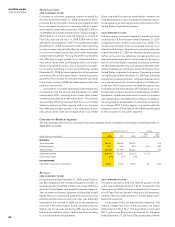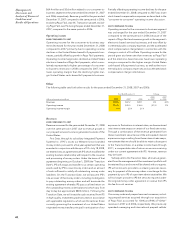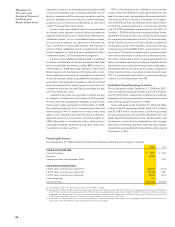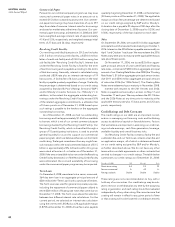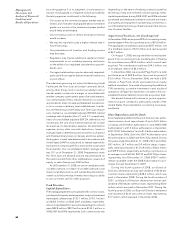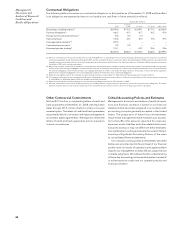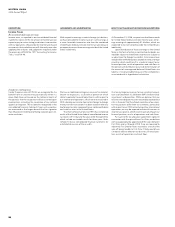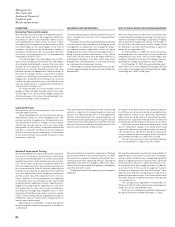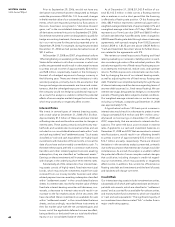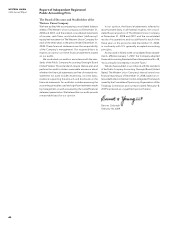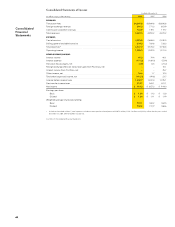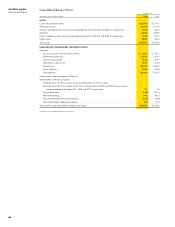Western Union 2008 Annual Report Download - page 39
Download and view the complete annual report
Please find page 39 of the 2008 Western Union annual report below. You can navigate through the pages in the report by either clicking on the pages listed below, or by using the keyword search tool below to find specific information within the annual report.
37
DESCRIPTION
Derivative Financial Intruments
We utilize derivative instruments to mitigate foreign cur-
rency and interest rate risk. We recognize all derivative
instruments in other assets and other liabilities in our
consolidated balance sheets at their fair value. Certain
of our derivative arrangements are designated as either
cash flow hedges or fair value hedges at the time of
inception, and others are not designated as hedges in
accordance with SFAS No. 133, “Accounting for Derivative
Instruments and Hedging Activities” as amended and
interpreted (“SFAS No. 133”).
Cash Flow hedges—Cash flow hedges consist of for-
eign currency hedging of forecasted sales and hedges
of anticipated fixed rate debt issuances. Derivative value
changes that are captured in accumulated other com-
prehensive loss are reclassified to earnings in the same
period or periods the hedged item affects earnings, to
the extent the change in the fair value of the instrument
is effective in offsetting the change in fair value of the
hedged item. The portion of the change in fair value that
is either considered ineffective or is excluded from the
measure of effectiveness is recognized immediately in
“Derivative (losses)/gains, net.”
Fair Value hedges—Fair value hedges consist of
hedges of fixed rate debt, through interest rate swaps.
The changes in fair value of these hedges, along with
offsetting changes in fair value of the related debt instru-
ment are recorded in interest expense.
JUDGEMENTS AND UNCERTAINTIES
The accounting guidance related to derivative account-
ing is complex and contains strict documentation
requirements.
The details of each designated hedging relationship
must be formally documented at the inception of the
arrangement, including the risk management objec-
tive, hedging strategy, hedged item, specific risks being
hedged, the derivative instrument, how effectiveness is
being assessed and how ineffectiveness, if any, will be
measured. The derivative must be highly effective in
offsetting the changes in cash flows or fair value of the
hedged item, and effectiveness is evaluated quarterly
on a retrospective and prospective basis.
If the hedge is no longer deemed effective, we dis-
continue applying hedge accounting to that relationship
prospectively.
EFFECT IF ACTUAL RESULTS DIFFER FROM ASSUMPTIONS
While we expect that our derivative instruments that
currently qualify for hedge accounting will continue to
meet the conditions for hedge accounting, if hedges
do not qualify for hedge accounting, the changes in
the fair value of the derivatives used as hedges would
be reflected in earnings which could have a significant
impact on our reported results.
As of December 31, 2008, the cumulative pretax
unrealized gains classified within accumulated other
comprehensive loss from such cash flow hedges that
would be reflected in earnings if our hedges were dis-
qualified from hedge accounting was $52.0 million.
As of December 31, 2008, the cumulative debt adjust-
ments from our fair value hedges that would be reflected
in earnings if such hedges were disqualified from hedge
accounting was a $58.1 million gain.
Capitalized Costs
We capitalize certain initial payments for new and
renewed agent contracts.
These capitalized costs are classified in our consoli-
dated balance sheets as “other intangible assets.” We
evaluate such other intangible assets for impairment annu-
ally and whenever events or changes in circumstances
indicate the carrying value of such assets may not be
recoverable. In such reviews, estimated undiscounted
cash flows associated with these assets are compared
with their carrying amounts to determine if a write-down
to fair value (normally measured by the present value
technique) is required.
The capitalization of initial payments for new and renewed
contracts is subject to strict accounting policy criteria and
requires management judgment as to the appropriate
time to initiate capitalization. Our accounting policy is to
limit the amount of capitalized costs for a given contract
to the lesser of the estimated future cash flows from the
contract or the termination fees we would receive in the
event of early termination of the contract.
Disruptions to an agent relationship, significant declines
in cash flows or transaction volumes associated with an
agent contract, or other issues significantly impacting an
agent’s business could require us to evaluate the recov-
erability of our capitalized initial payments for new and
renewed agent contracts prior to the annual assessment.
These types of events and the resulting analyses could
result in impairment charges in the future which could
significantly impact our reported earnings in the periods
such charges occur. We did not record any impairment
charges related to other intangible assets during the
years ended December 31, 2008, 2007 or 2006.
The net carrying value of our capitalized contract
costs at December 31, 2008 was $213.2 million.
37
Management’s
Discussion and
Analysis of Financial
Condition and
Results of Operations
Goodwill Impairment Testing
We evaluate goodwill for impairment annually and when-
ever events or changes in circumstances indicate the
carrying value of the goodwill may not be recoverable.
Goodwill impairment is determined using a two-step pro-
cess. The first step is to identify if a potential impairment
exists by comparing the fair value of each reporting unit
to its carrying amount. If the fair value of a reporting unit
exceeds its carrying amount, goodwill of that reporting
unit is not considered to have a potential impairment
and the second step of the impairment test is not nec-
essary. However, if the carrying amount of a reporting
unit exceeds its fair value, the second step is performed
to determine the implied fair value of a reporting unit’s
goodwill, by comparing the reporting unit’s fair value
to the allocated fair values of all assets and liabilities,
including any unrecognized intangible assets, as if the
reporting unit had been acquired in a business combi-
nation. If the carrying amount of goodwill exceeds its
implied fair value, an impairment is recognized in an
amount equal to that excess.
Reporting units are defined as an operating segment
or one level below an operating segment, referred to as
a component.
We calculate the fair value of each reporting unit through
discounted cash flow analyses which require us to make
estimates and assumptions including, among other items,
revenue growth rates, operating margins, and capital
expenditures based on our budgets and business plans
which take into account expected regulatory, marketplace
and other economic factors.
The determination of the reporting units also requires
judgment.
We could be required to evaluate the recoverability of
goodwill prior to the annual assessment if we experi-
ence disruptions to the business, unexpected significant
declines in operating results, a divestiture of a significant
component of our business, significant declines in mar-
ket capitalization or other triggering events. In addition,
as our business or the way we manage our business
changes, our reporting units may also change. These
types of events and the resulting analyses could result in
goodwill impairment charges in the future which could
materially impact our reported earnings in the periods
such charges occur.
The carrying value of goodwill as of December 31,
2008 was $1,674.2 million which represented approxi-
mately 30% of our consolidated assets.
We have not recorded any goodwill impairments
during the three years ended December 31, 2008.



